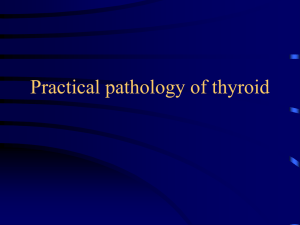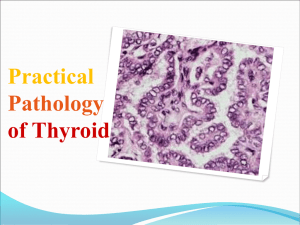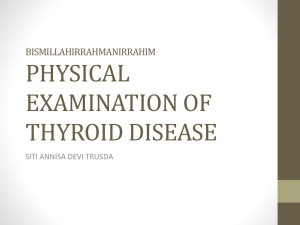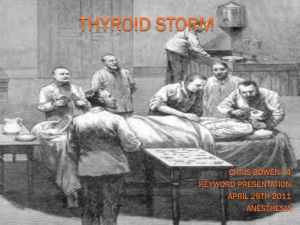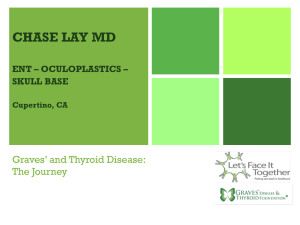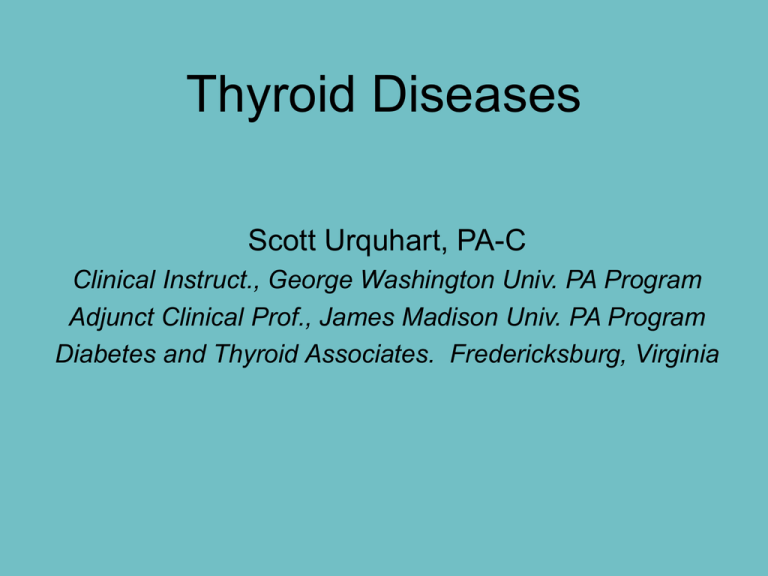
Thyroid Diseases
Scott Urquhart, PA-C
Clinical Instruct., George Washington Univ. PA Program
Adjunct Clinical Prof., James Madison Univ. PA Program
Diabetes and Thyroid Associates. Fredericksburg, Virginia
Q1: The most common thyroid
function disorder is?
•
•
•
•
1) Graves’ disease
2) Hypothyroidism
3) Sub-acute thyroiditis
4) Thyroid cancer
Q2: The most sensitive test for
thyroid function is?
•
•
•
•
1) Free T4
2) Free T3
3) TSH
4) Thyroid ultra sound
Q3: The best assay to confirm that
a patient’s hypothyroidism is
autoimmune in nature?
•
•
•
•
1)
2)
3)
4)
Thyroid stimulating immunoglobulins
Anti-nuclear antibody
TSH
Thyroid peroxidase antibodies
Q4: The best assay to confirm that
a patient’s hyperthyroidism is
autoimmune in nature?
•
•
•
•
1)
2)
3)
4)
Thyroid stimulating immunoglobulins
Anti-nuclear antibody
TSH
Thyroid peroxidase antibodies
Q5: Which is the best study to
confirm the etiology of a patient’s
thyrotoxicosis?
•
•
•
•
1)
2)
3)
4)
I123 thyroid scan/uptake
Neck CT or MRI
Thyroid ultrasound
Fine needle aspiration of the thyroid
Q6: Which is the best study to make
the initial evaluation for thyroid nodules
discovered on routine physical exam?
•
•
•
•
1)
2)
3)
4)
I123 thyroid scan/uptake
Neck CT or MRI
Thyroid ultrasound
Fine needle aspiration of the thyroid
Q7: Patient has a thyroid U/S showing
a solid dominant (>10mm) nodule and
normal thyroid function, what is your
next step?
•
•
•
•
1)
2)
2)
4)
Re-check thyroid U/S in 1 year
Fine needle aspiration of the thyroid
Neck CT or MRI
I123 thyroid scan/uptake
Q8: Thyroid U/S shows homogeneous
increased radiotracer uptake, the
diagnosis is?
•
•
•
•
1)
2)
3)
4)
Metastatic thyroid cancer
Graves’ disease
Toxic multi-nodular goiter
Toxic thyroid nodule
Q9: Methimazole or propylthiouracil
and used to treat hypothyroidism?
• 1) True
• 2) False
Q10: Which in not an appropriate
treatment for Graves’ disease?
• 1) Thyroidectomy
• 2) Anti-thyroid medications such as
propylthiouracil or methimazole
• 3) Levothyroxine sodium
• 4) I131 radioactive iodine
OBJECTIVES
• Order and interpret appropriate labs and studies
necessary for the diagnosis of the thyroid disorders
discussed in this lecture.
• Describe the common signs and symptoms of
hyper/hypothyroidism, work-up, treatment, and
follow-up.
• Provide a practical approach to the work-up and
diagnosis of thyroid nodules.
• Know when to refer.
Thyroid Diseases
Scott Urquhart, PA-C
Clinical Instruct., George Washington Univ. PA Program
Adjunct Clinical Prof., James Madison Univ. PA Program
Diabetes and Thyroid Associates. Fredericksburg, Virginia
Major Thyroid Abnormalities
Functional / Biochemical
• Hypothyroidism
• Hyperthyroidism
Structural / Anatomy
• Thyroid
– Goiter
– Nodules
• Cold
• Warm or Hot
– Cysts
– Malignancies
At Risk Population for Thyroid
Dysfunction
• Women, elderly, postpartum 4-8 months.
• FamHx of Hashimoto’s or Graves’ dz.
• PMHx or FamHX autoimmune diseases – SLE,
RA, DM1, Addison’s, vitiligo, pernicious anemia.
• Type 1 DM: ~20% increase risk for thyroid
dysfunction, mainly hypothyroid.
• Patients treated with amiodarone, lithium,
others.
Am. Thyroid Association, postpartum thyroiditis, accessed 6/4/2011
AACE Thyroid Guidelines, Endocr Pract. 2002;8(No. 6)
Basic and Clinical Endocrinology, Lange Series, 7th edition
HYPOTHALAMIC / PITUITARY
THYROID AXIS
• TRH: stimulate anterior pituitary to release TSH.
• TSH: stimulate thyroid for synthesis and release
of T4 and T3.
• Low T4, Low T3: stimulate TSH and TRH.
• High T4, High T3: inhibit TSH and TRH.
Basic and Clinical Endocrinology, Lange Series, 7th edition
THYROID HORMONES
•
•
•
•
T4 to T3 secretion ratio of 10:1.
T3 is 4X more biologically active than T4.
T1/2: T4 = 7days, T3 = 1 day.
T4,T3: 99% bound to protein, i.e. metabolically
inactive.
• From thyroid: 100% - T4, 20% - T3
remainder of T3 is from T4 to T3 conversion in
peripheral tissues.
Basic and Clinical Endocrinology, Lange Series, 7th edition
THYROID TESTING
Biochemical
1) TSH - highly sensitive, best test for
thyroid function.
1) Free T4 (FT4)- biologically active.
2) Free T3 (FT3) - biologically active.
- rarely need to check unless, TSH is low
or undetectable with a normal FT4.
THYROID TESTING
(more specific)
• Thyroid Peroxidase Antibodies (TPO-Ab’s)
- Hashimotos Thyroiditis
• Thyroid Stimulating Immunoglobulins (TSI’s) or
TSH receptor antibodies (TRAb).
- Unique to Graves’ disease
• I-123 RAIU (Radio Active Iodine Uptake)
evaluation for thyrotoxicosis, shape, size.
Don’t use to confirm hypothyroidism.
DON’T FORGET THE BASICS
• History of present illness and ROS.
• PMHx – postpartum
– Past Hx of thyroid pain/tenderness/nodule/
enlargement or goiter
– H/O autoimmune diseases
• FamHX – thyroid dysfunction, thyroid cancer,
Autoimmune diseases.
• Medications
• Systematic physical exam
Hypothyroidism
HYPOTHYROIDISM
• Prevalence: 4 - 8% general population.
• Mean age of Dx: 5th decade of life
• Female to male ratio: 10:1
Endocrine Secrets. McDermott, 4rd Edition
PRIMARY HYPOTHYROIDISM
• Identification on clinical basis can be
challenging.
• Symptoms generally vague.
• Frequently goes unnoticed, confused as
other health problems.
• Insidious onset + poor index of suspicion =
misdiagnosis
ETIOLOGY
• Autoimmune:
- Chronic lymphocytic thyroiditis = Hashimoto’s
- positive TPO-Ab’s
- remember postpartum thyroiditis
• Iatrogenic: I-131 RAI, total/subtotal
thyroidectomy, neck irradiation.
• Congenital: agenesis, dysgenesis.
• Drug induced: lithium, amiodarone,
chemotherapy, others.
Endocrine Secrets. McDermott, 4rd Edition
Basic and Clinical Endocrinology, Lange Series, 7th edition
Clinical Symptoms of
Hypothyroidism
• Fatigue
• Lethargy
• Arthralgias
• Hoarseness
• Cold intolerance
• Heavy menstrual flow
• Constipation
• Decreased memory
• Paresthesias
• Sleepiness
• Depression
• Weight gain ,edema
• Mental Impairment
• Muscle cramps
AACE Thyroid Guidelines, Endocr Pract. 2002;8(No. 6)
Braverman LE, et al. Werner & Ingbar’s The Thyroid. A
Fundamental and Clinical Text. 8th ed. 2000.
Clinical Signs of Hypothyroidism
•
•
•
•
•
•
•
•
•
•
•
Bradycardia
Coarse hair, hair loss
Delayed relaxation phase of deep tendon reflexes
Dry, cool, pale skin
Goiter
Hoarseness
Non-pitting edema (myxedema)
Puffy eyes and face
Slow movements
Slow speech
Thinning lateral third of eyebrows
AACE Thyroid Guidelines, Endocr Pract. 2002;8(No. 6)
Braverman LE, et al. Werner & Ingbar’s The Thyroid. A Fundamental and Clin. Text. 8th ed. 2000.
Example of Clinical Manifestations
of Hypothyroidism
• Patient example
– Fatigue (“no energy”), cold intolerance,
constipation, weight gain, fatigue, problems
with concentration (“mental clouding”), dry
skin
CLINICAL MANIFESTATONS
EXAM
• NECK: thyroid may be normal, enlarged,
symmetric/asymm., smooth or lumpy.
• HEART: bradycardia.
• EXTREMS: pretibial/ankle edema, dry cool
skin, brittle nails.
• NEURO: DTR’s with delayed relaxation phases
• HEENT: periorbital puffiness, loss of lateral
eyebrows, coarse/thinning hair.
LABORATORY EVALUATION
• TSH - high
• Free T4 - low
• Check both if new diagnosis to make sure
PITUITARY-THYROID AXIS intact.
• Consider TPO-Ab
Levothyroxine Sodium (LT4 )
• Exogenously administered LT4 hormone
• Indistinguishable from endogenous T4,
both in its physiologic effects and its
quantification as measured in blood
• LT4 is the treatment of choice as
replacement or supplemental hormone
therapy
• Branded preparations are preferred
Levothyroxine Bioequivalence Briefing Document. Available at:
http://www.fda.gov/ohrms/dockets/ac/03/briefing/3926B1_02_A-abbott.pdf
TREATMENT
• Levothyroxine (LT4), narrow therapeutic range
– 0.3 – 3.0 IU/mL, caution in lower range TSH.
• Brand vs. generic vs. T4 + T3 combination.
• Lifelong treatment, most cases
• Dosing: 1.6 mcg/kg/day = ~100 - 125 mcg/day.
• Compliance, empty stomach, competing agents
for absorption (Iron, Calcium )
• Check TSH no sooner than 6 weeks after initial
start of LT4 or any adjustment.
AACE Thyroid Guidelines, Endocr Pract. 2002;8(No. 6)
Therapy Monitoring
• Clinical and laboratory monitoring enable
– Evaluation of the clinical response
– Assessment of patient compliance
– Assessment of drug interactions, if applicable
– Adjustment of dosage, as needed
• Clinical and laboratory evaluations should be
performed
– At 6- to 8-week intervals while titrating
– Annually once a euthyroid state is established
Factors That May Reduce
Levothyroxine Effectiveness
• Malabsorption Syndromes
– Post jejunoileal bypass
• Drugs That Increase
Clearance
surgery
– Short bowel syndrome
– Celiac disease
– Rifampin
– Carbamazepine
– Phenytoin
• Reduced Absorption
–
–
–
–
–
–
–
• Factors That Reduced T4
Colestipol hydrochloride
to T3 Clearance
Sucralfate
– Amiodarone
Ferrous sulfate
– Selenium deficiency
Food (eg, soybean formula) • Other Mechanisms
Aluminum hydroxide
– Lovastatin
Cholestyramine
– Sertraline
Sodium polystyrene
sulfonate
Braverman LE, Utiger RD, eds. The Thyroid: A
Fundamental and Clinical Text. 8th ed. 2000.
Synthroid® [package insert]. Abbott Laboratories; 2003.
Thyroid Hormone Therapy
Special Treatment Populations
• Patients 50 years of age or with underlying
cardiac disease
– Initial dose of LT4 - 25 to 50 mcg/d
• Elderly patients with cardiac disease
– Initial dose of LT4 - 12.5 to 25 mcg/d
• Patients with heart failure
– Both hypo- and hyperthyroidism can
worsen heart failure
Levothyroxine Bioequivalence Briefing Document. Available at:
http://www.fda.gov/ohrms/dockets/ac/03/briefing/3926B1_02_A-Abbott.pdf
Treating Hypothyroidism Before and
During Pregnancy
• Encourage adherence with LT4 replacement
therapy before conception
• Monitor TSH levels before conception and during
first trimester
• Consider increase of LT4 dosage in athyreotic
patients by 25% - 50% when pregnancy is
confirmed
• Monitor TSH levels every 6 to 8 weeks throughout
pregnancy
• Reinstate pre-pregnancy LT4 dosage immediately
following delivery
Gharib H, et al. Endocr Pract. 1999;5:367-368.
Mandel SJ, et al. N Engl J Med. 1990;323:91-96.
Over-Replacement Risks
• Switching a narrow therapeutic index drug, such as LT4,
without retesting and re-titrating can cause inconsistent
TSH control, resulting in over-replacement
• Over-replacement risks (TSH <0.5 IU/mL)
– Iatrogenic thyrotoxic state
– Increased heart rate and myocardial contractility
– For cardiac patients, increased risk of angina and MI
– Reduced bone density/osteoporosis
– Psychiatric symptoms, such as anxiety, sleep
disturbance, irritability, and fatigue
Synthroid® [package insert]. Abbott Laboratories; 2003.
Braverman LE, et al. Werner & Ingbar’s The Thyroid. A Fundamental and Clinical Text. 8th ed. 2000.
Felicetta JV. Consultant. 2002;1597-1606. Available at: www.consultantlive.com. Accessed July 1, 2003.
Case 1
46 y.o. female presents with a 3 - 4 month
history of heavier than usual menstrual cycles,
fatigue, “feeling sleepy all of the time”,
depressed, constipation, problems
concentrating, cold intolerance.
• PMHx: unremarkeable
• FAMHx: Adopted.
Case 1 continued
• P.E. : DTR’s show delayed relaxation phases of
biceps and brachioradialis, non tender
symmetric goiter @ 2 times normal size without
nodules.
• LABS : TSH
77.02 (0.45-4.50)
Free T4 0.38 (0.8 – 1.50)
TPO-Ab
267 reactive greater 40.
Case 1 continued
• Dx: Hashimoto’s Thyroiditis
• Tx: 100 mcg qd, non-generic LT-4
Follow-up in 6 weeks and recheck TSH
• F/U: Feeling “90% better”
TSH 7.62
Increase to 112mcg qd.
Follow-up in 2 months.
• 2 months later
TSH – 2.11 (0.50 - 3.00).
Plan: follow and adjust LT-4 based on TSH
SUBCLINICAL HYPOTHYROIDISM
• Very difficult to diagnose clinically
• High index of suspicion, may be asymptomatic
• 4 -15% of general population*
• 20% of pts. over 60 y.o. (esp. women)**
• LABS: TSH - minimally high (6 - 10 IU/mL)
Free T4 – low normal
• TREATMENT: controversial, consider if
symptoms, lipid abnormality, if TPO-Ab positive
• Low dose LT-4 vs. surveillance, education.
*US Endocrinology Volume 4 Issue 1
*www.aace.com accessed 6/4/2011
Mild Thyroid Failure and
Neurobehavioral Abnormalities
• Conditions reported to occur more
frequently in patients with mild thyroid
failure
– Depression
– Anxiety
– Somatic complaints
– Cognitive abnormalities
Braverman LE, et al. Werner & Ingbar’s The Thyroid. A
Fundamental and Clinical Text. 8th ed. 2000.
Cooper DS. N Engl J Med. 2001;345:260-264.
Rationale for Treating
Mild Thyroid Failure
• Potential benefits from treatment
– Prevent progression to overt
hypothyroidism
– Improve serum lipid profile, which may
reduce the risk of death from
cardiovascular causes
– Reduce symptoms, including psychiatric
and cognitive abnormalities
Cooper DS. N Engl J Med. 2001;345:260-264.
Case 2
• Hx: 32 y.o. women referred for mildly
increased TSH 8.69 (0.46-4.68)
• Symtoms: mild fatigue, dry skin, “not
feeling my usual self”
• PMHx: no H/O thyroid disorders, or recent
of remote thyroid pain/tender.
• FAMHx: Mother, two maternal aunts with
hyperthyroidism.
Case 2 continued
• P.E. : Thyroid minimally enlarged and nontender, no nodules. remainder of exam
unremarkable.
• Labs:
TSH
7.5 (.46 – 4.68)
FREE T4 0.82 (0.80-1.50).
TPO-Ab 317 reactive greater than 40
Case 2 continued
• DX: Subclinical Hypothyroidism
• Hashimotos thyroiditis
• Tx: “Brand LT4” 25 mcg q.d.
Follow-up and TSH in 2 months.
• Follow-up: patient feeling better without
complaints
TSH 1.89 (0.5 – 3.0)
Education, need to follow
Hyperthyroidism
HYPERTHYROIDISM
ETIOLOGY
• Graves’ disease ( autoimmune ).
• Toxic multi-nodular goiter ( toxic MNG ).
• Toxic nodule (hot or warm nodule)
Common Symptoms and Signs of
Thyrotoxicosis
Signs
Symptoms
•
•
•
•
•
•
•
•
Nervous / shaky
Fatigue
Muscle weakness
Increased perspiration
Heat intolerance
Tremor
Palpitations
Appetite/weight changes
Menstrual disturbances
•
•
•
•
•
Goiter
Hyperactivity
Tachycardia / arrhythmia
Systolic hypertension
Warm, moist, or smooth
skin
• Stare and eyelid retraction
• Tremor
• Hyper-reflexia
Braverman LE, et al. Werner & Ingbar’s The Thyroid. A
Fundamental and Clinical Text. 8th ed. 2000.
GRAVES’ Dz
• ~75% of cases of hyperthyroidism.
• Thyroid Stimulating Immunoglobulins (TSI’s)
and / or TSH receptor antibodies (TRAb) levels
usually increased
• Incidence 2nd – 4th decade of life.
• ~5 times more likely in women.
Basic and Clinical Endocrinology, Lange Series, 7th edition
Thyrotoxicosis - work-up
• Labs- demonstrate thyrotoxicosis.
– TSH - Low or undetectable
– Free T4 and/or Free T3 – Increased
I123 thyroid scan / uptake
• Uptake is increased.
– 4 hour: normal ref. (5 – 15%)
– 24 hour: normal ref. (6 - 30%)
• Scan (anatomical findings via radiotracer
uptake)
– Homogeneous ( Graves’ Dz)
– multiple areas (Toxic MNG)
– single area (Hot or warm nodule)
Hyperthyroidism Management Guidelines, Endocr Pract. 2011;17(No. 3)
PATIENT EXAMPLE
GRAVES’
• 30 y.o. female with nervousness, shakiness, heat
intolerance, “fast / pounding heart beat”, wt loss,
light menses, and muscle weakness for 3 months.
• P.E. HR=118
–
–
–
–
Eyes—lid lag, stare,
Skin: warm/moist
Thyroid: large symmetric non-tender gland
Neuro—tremors, DTR’s – brisk, hyper-reflexic
• LABS: TSH: < 0.03 (0.45 – 4.50)
FT4:
2.8 (0.8-1.8)
Graves’ Work up Cont.
• I123 thyroid S/U
4hr = 28% (5 - 15%)
24hr = 76% (6 - 30%)
diffuse homogeneous uptake.
TREATMENT options
Treatment Options for
Thyrotoxicosis
• I131 RAI thyroid ablation
• Anti-Thyroid Drugs (ATD’s)
– Methimazole
– Propylthiouracil (PTU)
• Surgery: very rarely indicated
Hyperthyroidism Management Guidelines, Endocr Pract. 2011;17(No. 3)
Treatment with 1131 RAI
• Treatment of choice
– Goal is complete ablation i.e. hypothyroid
– Hypothyroid about 3-5 months post I131 Tx
• Follow Free T4 q 4-6 weeks until low
– Treatment: “brand” LT4
– Follow and treat as you would for hypothyroid
– Exception: the low TSH usually lags behind, often
for months, the normalization of the Free T4.
– Check Free T4 and TSH until the TSH becomes
normal or high, then only follow the TSH.
AACE Thyroid Guidelines, Endocr Pract. 2002;8(No. 6)
Treatment with ATD’s
• Anti-Thyroid Drugs (ATD’s)
– Methimazole: 10 – 60 mg/day, first choice
– PTU: 100 – 600 mg/day in 2-3 divided doses
• Only recommended for first trimester pregnancy
then change to methimazole
• Risk for liver failure with PTU
– Follow CBC – risk for agranulocytosis with either.
– Hepatic function panel – esp. with PTU
• Check TSH, Free T4 four weeks after start of Tx.
• Once patient stable and TSH normalized, check
TSH q 3-4months.
AACE Thyroid Guidelines, Endocr Pract. 2002;8(No. 6)
Hyperthyroidism Management Guidelines, Endocr Pract. 2011;17(No. 3)
Thyroid Nodules
How thyroid nodules or masses
are found?
• By HCP: palpation on routine exam
• By patient: rarely
• Incidentally
– CT scan or MRI of chest / neck
– Carotid Dopplers
• Thyroid Ultrasound
• I123 thyroid scan / uptake
Thyroid Nodules
• 5 categories:
–
–
–
–
–
Benign
Non-diagnostic
Follicular neoplasm/lesion
Suspicious
Malignant.
• Size - >1cm “dominant nodule”
AACE/AME/ETA Thyroid Nodule guidelines, Endocr Pract. 2010;16 (Suppl 1)
Thyroid Nodules
• I123 thyroid scan / uptake
– Hot or warm – hormone secreting nodules
– Cold nodules can be:
• Cysts
• Benign adenomas
• Malignant tumors
• others
AACE/AME/ETA Thyroid Nodule guidelines, Endocr Pract. 2010;16 (Suppl 1)
Ultrasound findings that increase
the risk of malignancy
•
•
•
•
•
Hypoechoic
Microcalcifications
Irregular margins
Intranodular vascularity
Rounded appearance; more tall than wide,
shape of the nodule
AACE/AME/ETA Thyroid Nodule guidelines, Endocr Pract. 2010;16(Suppl 1)
International Journal of Endocrinology and Metabolism. HORMONES 2007, 6(2):101-119
Suspicious for malignancy
•
•
•
•
•
•
Growing nodule
Fixed nodule
Firm or hard consistency
Cervical adenopathy
History of head and neck irradiation
Family history of medullary thyroid carcinoma (MTC),
multiple endocrine neoplasia type 2 (MEN 2), or papillary
thyroid carcinoma (PTC)
• Persistent dysphonia, dysphagia or dyspnea
• Age <30 or >60 years
• Male sex
AACE/AME/ETA Thyroid Nodule guidelines, Endocr Pract. 2010;16(Suppl 1)
International Journal of Endocrinology and Metabolism. HORMONES 2007, 6(2):101-119
Thyroid Nodule Work-up
• Assess for biochemical abnormality.
(TSH, FT4, ?FT3)
• If normal Labs
– U/S to evaluate: number and echotexture.
– Cytopathological Eval. Fine needle aspiration (FNA)
with or without U/S guidance.
• If abnormal Labs:
low TSH and or increased FT4/FT3
– I123 thyroid scan and uptake
– Nodule(s) hot or warm
– Treat options: I131 RAI, ATD’s, Surgery, refer to
endocrinologist for treatment
Am. Thyroid Assoc. Thyroid Nodule Guidelines. Accessed 6/4/2011
Basic and Clinical Endocrinology, Lange Series, 7th edition
Cold Nodules on I123 Thyroid
scan/uptake
• TSH and Free T4 normal
– Consider thyroid cancer, benign adenoma, or
thyroid cyst
– Ultrasound to delineate solid vs. cystic lesion
– Referral for ultrasound guided FNA biopsy
– If biopsy is suspicious for cancer or
demonstrates cancer, referral to surgeon with
ample experience in thyroid surgery.
Thyroid Malignancies
•
•
•
•
Papillary:
Follicular:
Medullary:
Anaplastic:
~80%
~15%
~3-5%
< 2%
Basic and Clinical Endocrinology, Lange Series, 7th edition
Problem Solving in Endocrinology and Metabolism. Kennedy and Basu, 2007
Closing Comments





